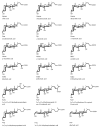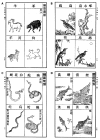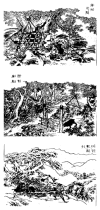Therapeutic uses of animal biles in traditional Chinese medicine: an ethnopharmacological, biophysical chemical and medicinal review
- PMID: 25110425
- PMCID: PMC4123376
- DOI: 10.3748/wjg.v20.i29.9952
Therapeutic uses of animal biles in traditional Chinese medicine: an ethnopharmacological, biophysical chemical and medicinal review
Abstract
Forty-four different animal biles obtained from both invertebrates and vertebrates (including human bile) have been used for centuries for a host of maladies in traditional Chinese medicine (TCM) beginning with dog, ox and common carp biles approximately in the Zhou dynasty (c. 1046-256 BCE). Overall, different animal biles were prescribed principally for the treatment of liver, biliary, skin (including burns), gynecological and heart diseases, as well as diseases of the eyes, ears, nose, mouth and throat. We present an informed opinion of the clinical efficacy of the medicinal uses of the different animal biles based on their presently known principal chemical components which are mostly steroidal detergent-like molecules and the membrane lipids such as unesterified cholesterol and mixed phosphatidylcholines and sometimes sphingomyelin, as well as containing lipopigments derived from heme principally bilirubin glucuronides. All of the available information on the ethnopharmacological uses of biles in TCM were collated from the rich collection of ancient Chinese books on materia medica held in libraries in China and United States and the composition of various animal biles was based on rigorous separatory and advanced chemical identification techniques published since the mid-20(th) century collected via library (Harvard's Countway Library) and electronic searches (PubMed and Google Scholar). Our analysis of ethnomedical data and information on biliary chemistry shows that specific bile salts, as well as the common bile pigment bilirubin and its glucuronides plus the minor components of bile such as vitamins A, D, E, K, as well as melatonin (N-acetyl-5-methoxytryptamine) are salutary in improving liver function, dissolving gallstones, inhibiting bacterial and viral multiplication, promoting cardiac chronotropsim, as well as exhibiting anti-inflammatory, anti-pyretic, anti-oxidant, sedative, anti-convulsive, anti-allergic, anti-congestive, anti-diabetic and anti-spasmodic effects. Pig, wild boar and human biles diluted with alcohol were shown to form an artificial skin for burns and wounds one thousand years ago in the Tang dynasty (618-907 CE). Although various animal biles exhibit several generic effects in common, a number of biles appear to be advantageous for specific therapeutic indications. We attempt to understand these effects based on the pharmacology of individual components of bile as well as attempting to identify a variety of future research needs.
Keywords: Bear bile; Bile acids; Bile pigments; Bilirubinates; Liquid crystals; Materia medica; Mixed micelles; Ox gallstones; Paleo-pharmacology; Phospholipids.
Figures





References
-
- Research Group for Collating Mawangdui Medical Books. A transcription of some of the medical texts contained in the silk manuscripts and unearthed at the No. 3 Han tomb at Mawangdui. Wen Wu. 1975;6:1–5 and 9: 35-48. - PubMed
-
- Research Group of the History of Medicine, the Academy of Traditional Chinese Medicine. A brief study of four lost ancient medical texts contained in the silk manuscripts recovered from No. 3 tomb at Mawangdui. Wen Wu. 1975;6:16–19.
-
- Ma JX. Achievements of materia medica in medical books unearthed at the No. 3 Han tomb at Mawangdui, Part I, Part II, Part III, and Part IV. Zhongyi Zazhi. 1986;5:57–60; 6: 59-61; 7: 57-59; and 8: 57-59.
-
- Chen SP. [Research on Calculus bovis] Zhongyao Tongbao. 1987;12:59–61. - PubMed
-
- Chen SP Anon. Shen Nong’s Herbal Classic (Shen Nong Ben Cao Jing) Shanghai: Shanghai Zhonghua Publishing House, c. 475 to 206 BCE, reprinted; 1941.
Publication types
MeSH terms
Substances
Grants and funding
LinkOut - more resources
Full Text Sources
Other Literature Sources
Research Materials

